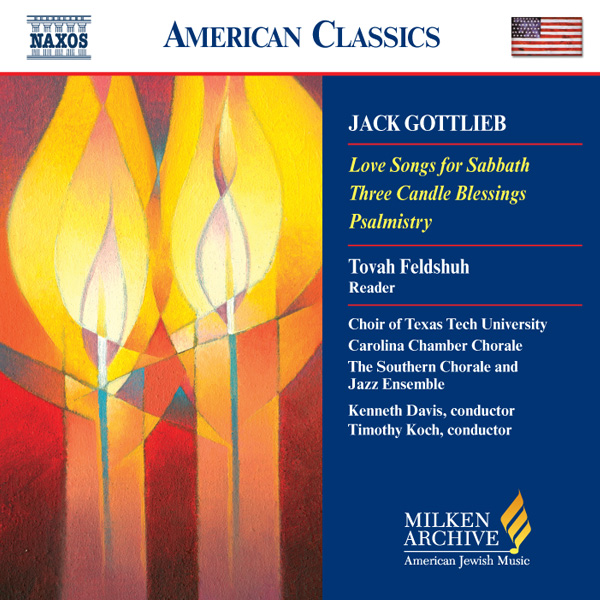Tracks
Track |
Time |
Play |
| Shalom Aleichem | 03:15 |
Liner Notes
In traditional Jewish homes on the eve of the Sabbath, just prior to sunset, the b’rakha is recited over two candles after they have been lit. As the assemblage gathers around the dinner table, it is also customary to sing shalom aleikhem, which inaugurates the Sabbath in the home for the entire household and any invited guests. The text of shalom aleikhem belongs to a special category of Sabbath “table songs” or “table hymns” known as z’mirot shel shabbat, which are sung both before and after the meal; and it is the first in the traditionally prescribed order of those hymns.
Conjoining the texts of the candlelighting b’rakha and shalom aleikhem may thus be regarded as a natural alliance, since both serve an inaugural function. Both customs are also practiced in many American Reform synagogues during the actual Friday evening service. The b’rakha is not cited in the Talmud, but it does appear in the 9th-century prayerbook, Seder Rav Amram Gaon. The custom of two candles or lights is said to derive from the fourth of the Ten Sinaitic Pronouncements [commonly but erroneously translated as the Ten Commandments. Ed.], which mandates Jews both to “remember” and to “observe” the Sabbath.
The shalom aleikhem poem is generally ascribed to 17th-century kabbalists in Safed. Something close to folk superstition characterizes the words of this four- stanza hymn, since angels appear to be described—or might be interpreted—as intermediaries between God and man. Indeed, some rabbinic authorities, such as the Vilna Gaon (1720–97), were dubious about its suitability on those grounds, and they originally objected to parts of it. Others, however, endorsed the practice as a poetic ushering in of the Sabbath peace, and the custom has prevailed.
Shalom aleikhem is based on an allegorical passage in the Talmud (Shabbat 119B) in which a Jew is escorted home from the synagogue on the eve of the Sabbath by two angels—one evil and the other beneficent. If they find no Sabbath peace in the home, the evil angel exclaims, “May it [also] be thus on the next Sabbath!” But if they find the home properly prepared for the Sabbath and infused with the special Sabbath spirit of peace, the beneficent angel then expresses the wish that it also be the same there on the following Sabbath. Even the evil angel is then divinely compelled to give his assent by responding “amen.”
This well-known melody for shalom aleikhem was composed by Rabbi Israel Goldfarb (1879–1956), who is said to have written it while sitting on a bench near the alma mater statue at Columbia University. It was first published in the volume Friday Evening Melodies (1918) and later appeared in Goldfarb’s collection Sabbath in the Home (1953). Although many songs from the American Yiddish theater—as well as Yiddish labor-oriented and revolutionary songs—eventually achieved anonymous folksong status outside the United States, Goldfarb’s melody is one of very few American liturgical tunes to gain standard acceptance and currency abroad. In the popular imagination it nearly swept away all earlier tunes for this poem that were known in America, except among certain Hassidic circles; nor have any subsequent shalom aleikhem melodies shaken its predominance. And even where other shalom aleikhem melodies are currently part of many family repertoires, such as in England, Goldfarb’s is often familiar as well. There is a story about a Jew in India who believed it was a tune handed down from his ancestors.
Although the form of this tune is A-B-B-A, it has sometimes been performed mistakenly as A-B-A-B, a matter that is discussed by Cantor Pinchas Spiro in his article “Israel Goldfarb’s Shalom Alechem” (Journal of Synagogue Music; xvi, 1980). In his watershed scholarly anthology, Hebraüisch-Orientalischer Melodienschatz (Hebrew-Oriental Melodies, Leipzig, 1932), musicologist Abraham Zvi Idelsohn erroneously attributed the melody to “S. Goldfarb” (ix, no. 707)—Samuel Eliezar Goldfarb, Israel’s brother. Samuel Goldfarb was a liturgical composer and Jewish music educator in his own right, and the brothers did collaborate on other occasions, especially on songsters for synagogue, home, and school use.
In Goldfarb’s original tune, the word elyon is set exclusively on the supertonic, on which it remains. But I have followed the popular habit, perpetuated by oral transmission, of extending it melismatically up a fifth. (That dominant pitch, however, is present in Goldfarb’s accompaniment at that point.) To facilitate congregational singing, there are other small notational differences as well.
Lyrics
SHALOM ALEIKHEM WITH CANDLE BLESSING
Sung in Hebrew and English
You are worshiped, O Lord, our God, King of the universe, who
has made us holy through His commandments, and who has
commanded us to kindle the Sabbath lights.
Peace be to you, O messengers of peace,
Messengers of the Most High,
The Holy One blessed is He.
Enter in peace, O messengers of peace,
Messengers of the Most High,
The supreme and eternal King,
The Holy One blessed is He.
Bless me with peace, O messengers of peace,
Messengers of the Most High,
The supreme and eternal King,
The Holy One blessed is He.
Depart in peace, O messengers of peace,
Messengers of the Most High,
The Holy One blessed is He.
Credits
Composer: Jack GottliebPerformers: Cheryl Bensman-Rowe, Soprano; Neil Farrell, Tenor; Metropolitan Brass Ensemble; New York Motet Choir; Stephen Sturk, Conductor
Publisher: Theophilous Music, Inc.
